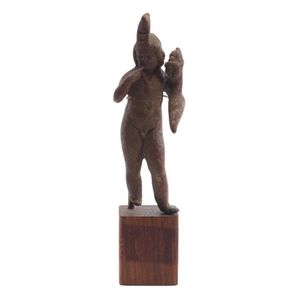Egyptian Bronze Harpocrates Figure
A solid cast Egyptian bronze figure of Harpocrates, Ptolemaic period, circa 332-30 B.C. Modelled wearing the upper and lower crowns of Egypt, holding a cornucopia, and with index finger of right hand to mouth symbolising childhood. Presented on custom wood and brass display stand. 10.2 cm high
You must be a subscriber, and be logged in to view price and dealer details.
Subscribe Now to view actual auction price for this item
When you subscribe, you have the option of setting the currency in which to display prices to $Au, $US, $NZ or Stg.
This item has been sold, and the description, image and price are for reference purposes only.
- Bronze - An alloy of copper and tin, traditionally in the proportions of about 9 parts of copper to 1 part of tin.
The discovery of bronze in Western Asia in the 4th century enabled people to create metal objects which were superior to those previoulsy possible because of its strength and hardness, and it has been used throughout the world for weapons, coins, tools, statuary and other decorative items.
It is very fluid in a molten state, and its hardness, strength when set, and non-corrosive properties makes it most suitable for casting sculpture. - Circa - A Latin term meaning 'about', often used in the antique trade to give an approximate date for the piece, usually considered to be five years on either side of the circa year. Thus, circa 1900 means the piece was made about 1900, probably between 1895 and 1905. The expression is sometimes abbreviated to c.1900.
- Cornucopia - The cornucopia, literally the horn of plenty, is a symbol of abundance and wealth. It is traditionally is represented by a curved goat horn overflowing with grain and fruit.
Modern cornucopias are often depicted as horn-shaped baskets filled with food, and this symbol is often associated with the harvest. This decorative device has a long and ancient history, with roots in Greek mythology.
In one version, when Zeus was playing with the goat Amalthea he accidentally broke off one of her horns. To atone for this, Zeus promised Amalthea that the horn would always be full of whatever fruits she desired. This became the cornucopia of the Roman goddess Copia, the personification of plenty. Other goddesses, including Fortuna and Pax, also held the cornucopia.
In furniture and decorative arts, cornucopia as a decorative element have been popular since the 16th century and can be found on items as diverse as light fittings and candelabra to clocks, sculpture and statuary and furniture.
In ceramics, cornucopia shaped vases were popular in the 19th century, in singles and pairs.
This item has been included into following indexes:
Visually similar items

Khymer stone torso, Cambodian, probably 11th/12th century. 35 cm high. Provenance: The Contents of Musk Farm
Sold by
in
for
You can display prices in $Au, $US, $NZ or Stg.

A Japanese ivory carving of an elephant fighting a tiger, Meiji period (1868-1912), 9 cm high
Sold by
in
for
You can display prices in $Au, $US, $NZ or Stg.

A very large stone carved figure of Pan on a stone plinth, 17th century. 200 cm high, 100 cm wide, 52 cm deep
Sold by
in
for
You can display prices in $Au, $US, $NZ or Stg.

Large French composition stone figure of a rooster
Sold by
in
for
You can display prices in $Au, $US, $NZ or Stg.
